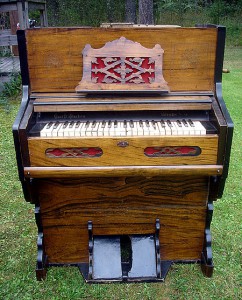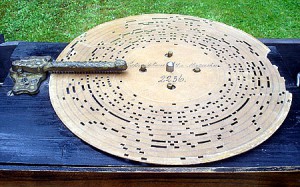Self-playing reed organs, with or without keyboards, were extremely popular around the turn of the twentieth century. One of the most popular models was the German Ariston Organette, a table-top organ with a replaceable cardboard perforated disc, that probably inspired J.P. Nyström in Karlstad when he launched his first “reform organ” in 1888.
Organs of a similar type were manufactured by C.A.V. Lundholm in Stockholm and P.A. Lindahl in Kalmar, and their popularity continued through the rest of the 19th century until 1913, when production seems to have ceased. On the discs we find not only hymns and spiritual songs, but also folk, dance and marching music such as “Donauwellen”, “Wermlandspolska” and “Finska Rytteriets Marsch”.
An interesting exception are the organs of Carl G. Nyström in Kristinehamn. These organs are also driven with perforated discs. However, the mechanics do not activate the organs keys (as with other makers), but instead a separate wind chest that might perhaps rather be characterised as a “built-in music box”.
In the summer of 2016, we not only managed to acquire one of these rare organs for Klaverens Hus, (KH 654), but also fit in a small car without having to disassemble anything other than the two carrying handles on the sides. The keyboard has a range of four octaves, and the built-in music box has 24 tones.
Christofer Nöring (2016)

